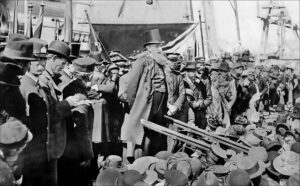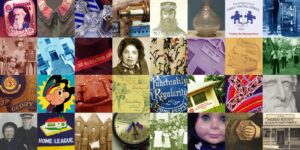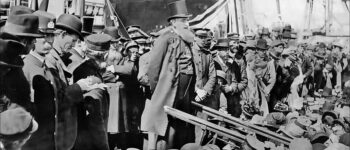1899: A General Inspection
March 20, 2022
By AHNZ
 Today in New Zealand history, 20 March, 1899,: The third visit to New Zealand by the Salvation Army’s founder, General William Booth. His religious army of Social Justice Warriors (complete with self-given rank¹) were a sect of Methodism and they were riding high at the end of the C19th. Thousands of New Zealanders came to hear what Booth had to say, particularly young people. The Salvation Army had started in this country with just two English missionary men out of Port Chalmers on 27 March, 1883.
Today in New Zealand history, 20 March, 1899,: The third visit to New Zealand by the Salvation Army’s founder, General William Booth. His religious army of Social Justice Warriors (complete with self-given rank¹) were a sect of Methodism and they were riding high at the end of the C19th. Thousands of New Zealanders came to hear what Booth had to say, particularly young people. The Salvation Army had started in this country with just two English missionary men out of Port Chalmers on 27 March, 1883.
By the turn of the century the Army was so successful and wealthy that it was able to purchase two islands in Hauraki Gulf. Pakatoa Island was followed up by the purchase of Ruth Island (Rotoroa Island.) The purpose was to help reform New Zealand’s drunks and perhaps add them to the Army’s swelling ranks.
Like Don Buck’s Gumdiggers Camp in West Auckland, these islands to the east were granted special status under the law to take in drunkards to serve their sentence. The convicts no doubt provided free labour to the Army to clear and develop Pakatoa which then became a segregated island for females. The males were then sent to the next purchased island, Rotoroa, to supply convict labour in clearing and farming it in the guise of sobering up and reforming. Had New Zealand enough convicted drunks this pattern may have continued until the Salvation Army took over every island including the main ones; I’m sure that was their very plan.
Kate Shepherd Victimhood Culture and Seddon Slave Culture capped off the turn of the century so Booth’s visit in 1899 would have seen New Zealand at a high point of lefty idealistic Social Justice religiosity. Booth’s religion offered something highly organised to be a part of and a highly sectarian platform from which to look down on all the other churches. The Salvation Army inherited, took over, and militarised the Temperance Movement that once belonged to women like Shepherd and Anna Stout.
“The Waikare, with General Booth, Commandant Booth, and staff, and the Federal Band on board, arrived at (he Bluff at 6 o’clock to-night . after a very pleasant passage. General Booth, who after the recent severe attack of dysentery was greatly tried by the intense heat of Adelaide and Melbourne, has been much restored by the cooler breezes off, the New Zealand coast, and he is sanguine of a successful series of meetings. General Booth addressed a considerable crowd gathered on the wharf prior to leaving for Invercargill. Ho was received at the Invercargill railway station by the Mayor (Mr John Stead), who, on ‘behalf of the town of Invercargill and the colony of New Zealand, welcomed him. The General briefly addressed the great crowd in reply. The Theatre Royal was thronged with en enthusiastic audience, who accorded General Booth a warm welcome. The Mayor presided.” – Arrival of General Booth, ODT (21 March, 1899); Papers Past
“A working-class version of revivalism was the secret of the success of the Salvation Army. This pattern particularly attracted young people, who were more open to a wave of emotion, but it also revived flagging zeal in colonies who sensed that church life in the colony was tougher and less integral to the community.” – p119, Lineham (2017)
“Buck was a failure at business until he negotiated a sweetheart deal with city magistrates to sentence criminals to being a free labour force for himself as an alternative to prison.” – 1917: Don Buck’s Gumdigger Camp Scrapped, AHNZ
“The Salvation Army denomination excelled at showing off with brass bands, uniforms, and militaristic titles like captain, major, lieutenant etc. When the Kirks married there was a great Victimhood Culture tide to surf, as for Uncle Scrim and Hubert Holdaway…the devout Salvation Army boy became an apostate. Those who abandon their religion make a cult of culture: Kirk took all that lefty idealistic Social Justice religiosity they raised him on and channeled it into politics. Kirk converted to Statism, Government would be his new church now.” – 1974: Kirk Out, AHNZ
 New Zealand forces of culture in the early 2020s are much like the position we were in when Booth visited (Bluff, Invercargill, Lyttelton, Wellington, New Plymouth, Auckland) in 1899. ‘Climate Change’ was upon Booth and his people, they would soon be yesterdays news as Honour Culture rose up to dominate our national scene. Rather than the boogieman of COVID-19, Booth’s Army pressed alcohol as the terror poisoning our people. However, theirs was an adaptable formula ready for the mentality of the Great War. When our soldiers came home with a renewed taste for drink that could only help an organisation that depended on sinners to reform from the influence of the demon alcohol.
New Zealand forces of culture in the early 2020s are much like the position we were in when Booth visited (Bluff, Invercargill, Lyttelton, Wellington, New Plymouth, Auckland) in 1899. ‘Climate Change’ was upon Booth and his people, they would soon be yesterdays news as Honour Culture rose up to dominate our national scene. Rather than the boogieman of COVID-19, Booth’s Army pressed alcohol as the terror poisoning our people. However, theirs was an adaptable formula ready for the mentality of the Great War. When our soldiers came home with a renewed taste for drink that could only help an organisation that depended on sinners to reform from the influence of the demon alcohol.
The Salvation Army is still very much with us with churches nationwide and (presumed tax-free) charity retail shops in almost every city and town. They continue to own Rotoroa Island which, having been cleared and cultivated strenuously by our pioneers, is now being deliberately converted back into native scrub. That’s normal to the age we live in and one day it’ll go back the other way again as productivity becomes a higher value in our culture than virtue signalling. The Army is also active in political lobby groups and in prison outreach.
Their giant status in New Zealand was bled off by two big changes that I can think of. One was the 1930s cultural migration into politics. With the success of Labour 1.0 the Social Justice Warrior found his outlet in the public sector rather than the private. New Zealand allowed finger-wagging Nanny State type people with a love of rank and dominance hierarchies and policy and rules and vice legislation and Red Tape and bureaucracy to run the country. Government grew, the church shrank; The State remained. For example, the devout Salvation Army youth Cadet Norman Kirk converted to a secular Prime Minister of Labour 3.0. The genetic and memetic descendants of Booth’s Kiwi Army are now to be found working in the Public Service in Wellington or its numerous branch offices around the country. Eg. Holding court for “clients” in Housing New Zealand or Winz offices today the same way a Salvation Army Captain at Divisional Headquarters received and processed petitioners 100 years ago.
Secondly, the 1930s high point of the Salvation Army wasn’t only drawn away into secular politics but a new rival organisation for the drunk rehabilitation marketplace: Alcoholics Anonymous (est. 1935, Ohio.) In August 1946 the first AA representative was on the map, Ian MacEwen of Richmond. “By 1951 there were six groups in New Zealand, at Auckland, Hastings, Nelson, Wellington, Dunedin and Invercargill, with a total membership of around 60. From that time on there was a slow but steady growth throughout the country. Today there are about 4,000 members in some 400 groups..”² The AA really hit its stride after 1961 so that ever after if someone is looking for help with alcohol abuse they will first think of the secular AA rather than a sect of the Methodist church. The market had been captured. No great organism remains long without fracturing and Booth’s Army has been no exception. The fact it is still flourishing today shows that it still serves important social functions that cannot be denied.
Note: My criticism of Alcoholics Anonymous is from an Anarchist mental health point of view. It’s palliative care and axiomatically anti-cure. When you’re in AA you are supposed to be in AA for life, forever, always joined to a Sponsor and always attending regular meetings. You must self-identify as an Alcoholic. You are always at risk, you are broken, you are never recovered or cured or resolved for forgiven. What is this, then, than a secular version of Original Sin? Christians have their Bible, AA has its Big Book. AA is as much an egregore as any chuch although it is highly specialised and confined to its niche.
—
1 Not to suggest that The State’s offices and ranks are not also autonomously generated
2 Ref. A brief history of A.A. in New Zealand, AA New Zealand
Image ref. The Salvation Army 2020 calendar, New Zealand: History & Natural History, Facebook (2020)
Image ref. Holdaway and Pattrick – Flying Brigade; Salvation Army.org.nz
Image ref. Cover photo, Salvation Army Archives NZFTS, Facebook (2016)
Ref. Sunday Best, Peter Lineham (2017)
Ref. Rakino Island, Hauraki Gulf, also became an organ of an ambitious heterodox dream; 1963: The Great Ricardo, AHNZ
 Like Comment Share
Like Comment Share





